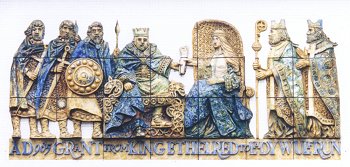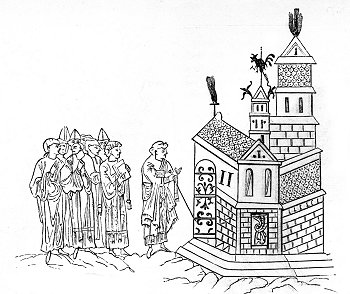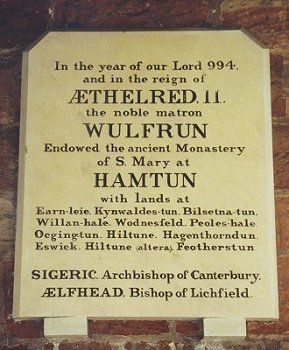LADY WULFRUNAWolverhampton's Founding MotherJenny Jones Jenny Jones was Wolverhampton South West's first female M.P.. In her maiden speech she mentioned Wulfruna and kept Wolverhampton's name firmly in her fellow members' minds whenever she spoke. Here Jenny gives an account of our founder. Wolverhampton was born at a time of national turmoil and the woman from whom the city and its inhabitants derive their names was in the thick of it. Wulfruna was a Saxon noblewoman who lived over a thousand years ago in the Kingdom of Mercia. The exact dates of her birth and death are not known but the Saxon Chronicles of that time give us sufficient information about Wulfruna to build up a picture of an interesting and important life. Wulfruna lived at a time when Mercia dominated Saxon politics. Saxon England was a loose, and sometimes tension ridden, federation of seven kingdoms. The three dominant ones, Wessex, Mercia and Northumbria, seemed to be in a constant state of mutual hostility. Mercia's period of dominance was sandwiched between the decline of Northumbria, following defeat at the hand of the Picts late in the seventh century, and the rise Wessex in the tenth century, after the Danish Vikings had done with pillaging and laying waste to Mercia. The kingdom of Mercia produced five kings, Penda, Peada, Wulthere, Aethelred and Offa, whose work ensured its supremacy during the Saxon era. It was Aethelred who secured Wolverhampton's place in the history books - but more of that later. Mercia represented the front line between Danish Viking attacks and general land grabbing on one side and English resistance on the other. As a result the kingdom was under constant attack from the Danes from 850 AD onwards. Tamworth - the Mercian capital - was the subject of frequent assaults and re-fortification. Monastic annals of the time (known as the Saxon Chronicles) tell of a kingdom in a state of flux and turmoil, with Harold Bluetooth of Denmark launching wave after wave of raids against the region. However around 910 AD the Danes got their come uppance when the King of Wessex, Edward Elder, intercepted the Danes and defeated them at the Battle of Tettenhall. The Chronicle actually says the battle was near Tettenhall and some historians have moved the site of the battle to Wednesfield; but there is little evidence either way. The Vikings however were not to be put off and in 943 they were back. Their leader, Olaf Guthfrithson, led a fierce and bloody attack on Tamworth which resulted in the capture and imprisonment of Wulfruna. This act demonstrates her importance. She, like all Saxon noblewomen, held land and property in her own right on an equal basis to Saxon noblemen. She was also a member of the powerful Mercian ruling family. The Danish Vikings, who were intent on raising money by extortion, clearly saw a good opportunity. At that time their style was to descend on a settlement or town and suggest that the inhabitants would like to pay for peace and to be left alone. Alternatively they would kidnap a wealthy local dignitary and hold them to ransom. The money raised using this method became known as Danegeld. Clearly Olaf knew that Wulfruna was sufficiently important to extract a high price for her release. Wulfruna survived her ordeal and went on to produce two future key figures in Saxon England: Aelfhelm, who became Ealdorman of Northumbria, and Wulfric Spott, who founded Burton Abbey.
In 985 King Aethelred granted lands at a place referred to as "a Heantun" (Saxon for high place) to Wulfruna by royal charter. The lands were granted in perpetuity and the charter outlines what torments of hell awaited anyone who tried to violate it. This charter and the gift were recorded in Saxon Chronicles and this was probably Wolverhampton's first appearance in the history books. The lands granted were not empty; they contained livestock, farms, mills, other buildings and, of course, their inhabitants. Wulfruna already had lands in the Trent Valley around Burton. The "10 cassates" of land granted to her in the charter was defined by reference to streams, springs, fields and marshes rather than to man-made features, although three Saxon crosses were used as markers.
Wulfruna established a manor house in the Gorsebrook area of the town. The spot known as Wulfruna's Well is supposed to be a reference to a spring which ran past the manor house. But some historians feel that the spring was probably mythical and the present monument on the site is a Victorian drinking fountain. Wulfruna's town developed as a market centre and in 994 she in turn granted land at Bilston, Willenhall, Pelsall and elsewhere to a monastery at Heanton so that "mass may be chanted there for evermore". The witnesses to her charter read like a Who's Who of Saxon England - one King, two archbishops, and twelve bishops.
Wulfruna was clearly important and influential because monasteries at that time were about political power as well as ecclesiastical clout. The monastery went on to become a minster, which in turn became the St. Peter's Church we know today. This event, also documented in the Saxon Chronicles, refers to the town as Wulfruna's Heantun and the name stuck. Wulfruna received her charter from King Aethelred late in her life. The statue in the centre of Wolverhampton, commemorating this event, depicts her as young woman -which she was not. She died shortly after founding the monastery and is believed to have been buried at a convent in Tamworth, which she also founded. Her son, Wulfric, mentions this in his will. After her death Wolverhampton continued to thrive and in the eleventh century Saxon and Norman kings showed an interest in the place, thus attesting to its importance. In 1050 and 1070 Wulfruna's Heantun appears in royal charters. The 1070 charter granted the royal free chapel to William the Conqueror's own chaplain, Samson of Bayeux. Wolverhampton had clearly made it.
So what of Wulfruna? Evidence shows her to have been an important figure in the most influential and powerful kingdom of Saxon England. She used her influence to establish Wolverhampton's wealth and importance, and she was clearly generous by the standards of the time. Her two sons went on to become powerful figures in their own right. Wolverhampton is unusual not only because it was founded by a woman but because that woman managed to secure the town's safety and future prosperity at a time of great turmoil. No mean feat! Today walking round the city several references to her can be found, the most notable being the statue, by Sir Charles Wheeler, in front of the church which she founded a thousand years ago - St. Peter's. There is a shopping centre, a street, a hall and, until quite recently, a college all named after her. And she also managed to appear in an MP's maiden speech. Wulfruna lives! |




